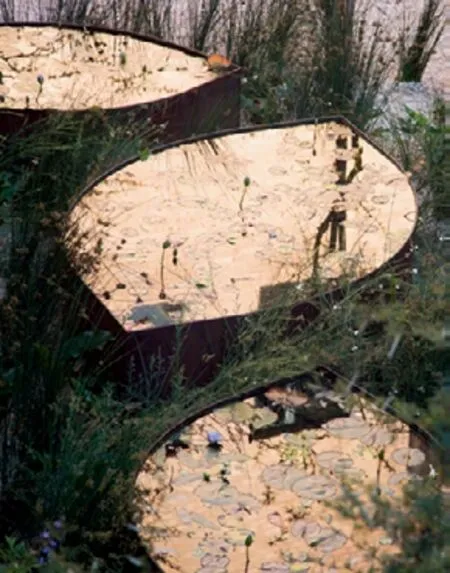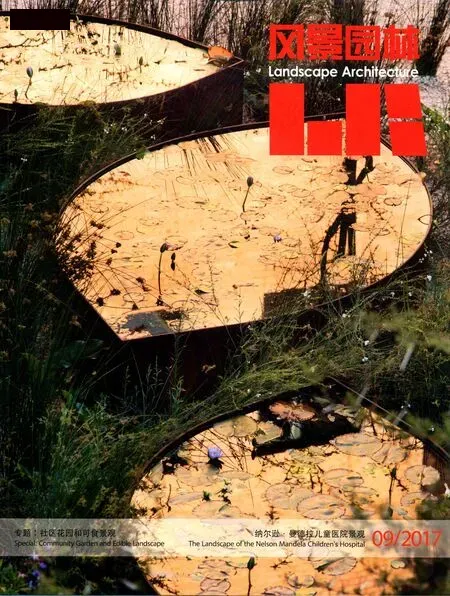城市中的田园
城市中的田园

记得大学读书期间,同济大学校园的宣传栏中贴出一张公告,点名通报未在规定时间内宰杀家中饲养的家禽的一些教师,其中包括陈从周先生。同学们都笑着猜测,陈先生养鸡应该是用于观察画画,或是留着待贝聿铭先生来访时能更好地设家宴招待。
20世纪80年代以前,饲养家禽是中国城市的普遍现象,与乡村类似,城市居民每天清晨听到的第一个声音往往是公鸡的啼鸣。那时,许多城市建筑密度不高,城中有大片田野。我生长的城市兰州是一个沿着黄河分布的线形城市,在城区各个组团之间是农田、菜地和果林,左邻右舍都饲养家禽,住平房或是住宅楼一层的居民会在院子里种植蔬菜、玉米或是葡萄,以此来弥补食物的不足、增加营养供给,整个城市就像一个大村庄。
要理解当时的城市并不难,费孝通在《中国士绅》中曾描述20世纪40年代的中国城市:“在城内通常有一些可以种植的土地,即使是在北京和南京这样的大城市,也有它的农业区。这些田地被围在城里,可以供给居民必要的蔬菜和其他不易储藏的农产品。依照传统的观点,理想的‘城’是一个能自给自足的堡垒。”城市生活需要农产品不间断地供应,在存贮和运输技术极不发达的情况下,许多农产品都需要在城市周边甚至内部就近生产。再加上政策措施失当和农业产量低下,以致城市食品供给极为匮乏,无法满足城市居民日常的食品需求。因此,城市中的土地被人们自发地利用起来种植蔬菜作物或者饲养家禽,用以补充食物的不足、改善生活条件。那时城市的某些区域,尤其是居民区,或多或少地都像一个大村庄,都具有浓厚的乡村气息。
今天,中国城市的农产品供给极其丰富,产品源自全国各地甚至全世界,城市附近的农业用地在生产上的意义不再重要。随着快速的城市化进程,这些土地迅速转变成新的城市区域。原来城市中带有院子的平房和低层住宅被密密麻麻的高层建筑所取代,各种整齐漂亮的公园绿地填满了建筑之间的空隙。城市中的土地失去了生产食物的必要,城市也随之失去了以往的田园气息。如今城市中的孩子没有在清晨被公鸡啼叫唤醒的经历,也没见过生长在土地上的庄稼和蔬菜。中国的城市已远离田园和农村,30年前田园化的城市景观仅仅存在于一些文学作品、影像记录和曾经在那个年代生活的人的记忆之中。
与此相对照的,一些最早实现工业化的发达国家反而保留了更多更完整的田园风景,不仅整个国土一派田园风光,城市中也更加富有乡野气息。20世纪90年代,当我初次迈出国门,如饥似渴地考察学习欧洲现代化的城市与景观时,惊讶地发现欧洲许多中小城市都充满了田园气息,绿地中的花草树木多是朴野自然的乡土种类,许多人家的院子被装点得像个农舍,城市中不少公共空间也被设计得像一片乡村野地。
其实,欧洲城市在工业化和城市化进程中也经历过迅速改变的过程。针对工业增长和人口膨胀带来的城市环境恶化和社会结构失调问题,很多学者提出过改善生存环境的思想策略。19世纪中叶,德国医生施雷伯提出在城市中建设家庭园艺花园的设想,这是普通市民、特别是低收入阶层可以租赁的小块花园,用以种植蔬菜和果树、饲养家禽,来增加食物供给。后来,这些花园的功能更多的是让奔波忙碌的市民放松身心、接触自然,体会耕耘的乐趣和收获的喜悦。这些成片的小花园也是城市中社区花园的一种类型,它们为城市带来了浓厚的田园气息。19世纪末,英国社会学家霍华德提出的“田园城市”是一种兼具城市和乡村优点的城市设想,城市的四周被农业用地所围绕,其中有耕地、牧场、果园和森林,城市居民可以得到新鲜和充足的农产品供应。这些思想后来一直影响着欧洲的城市结构和风貌。在欧洲的许多城市中,自然景观和乡村景观都被纳入到城市的结构之中,而家庭花园和社区花园则保留了许多实用性和生产性的特点,不少城市公园的景观以体现田园风光为主。许多城市在拥有现代化基础设施和良好生活品质的同时,仍然可以保持恬静、轻松与安逸的田园气息。
中国的城市原本就是在农耕文化中产生的,城市与田园彼此容纳、互相支撑。中国人对土地和自然的热爱是一种延续千年的人文情怀,田园生活是人们的一种理想生活状态。无论城市怎样发展变化,在城市中留出足够的具有田园气息的空间,让市民能够感受自然、参与园艺和农事活动,让孩子们认识自然、体会收获的快乐,这不应该只是一种畅想,而应该成为现实。
2017年9月10日
Pastoral in the City
I remember it happened when I was studying at Tongji University, a notice posted on campus, notifying those teachers who did not kill the poultry within the allotted time, including Mr. Chen Congzhou. All the students laughed and speculated that Mr. Chen’s chickens should be used to observe and paint, or to hold a feast at home for a better reception once Leoh Ming Pei paid a visit.
Before the 1980s, keeping poultry is a common phenomenon in domestic families in China. Like in rural area, the fi rst sound the city dwellers heard usually was the loud crows cocks made every morning. The buildings in many cities was not yet in high density at that time and there were still large fi elds. My hometown Lanzhou is a linear city along the Yellow River. The connectives between the building clusters in the city were farmland, vegetable plots and fruit garden, feeding poultry was also popular in the neighborhood.Residents living in bungalows or the first floor of buildings will grow some vegetables and corn or grapes in the yard, make up for the food shortage and nutrition supplies. The whole city is just like a large village.
It is not dif fi cult to understand the city at the time. Fei Xiaotong described the city of China in 1940s in the book Chinese Gentry:“Land plots were usually reserved for planting in cities. Even in such big cities as Beijing and Nanjing, there were agricultural areas.These fields enclosed in the city could provide residents with the necessary vegetables and other hard-to-store products. From the conventional point of view, the ideal ‘city’ is a self-sufficient fortress.” Urban life requires continuous supply of agricultural products, which needed to be produced within or around the city especially when the storage technic and transportation were extremely underdeveloped. Coupled with the improper policies and low agricultural output, urban food supplies were too scarce to meet the daily food needs of urban residents. As a result,lands in the city were spontaneously developed to grow crops and vegetables or to raise poultry to supply food de fi ciencies and to improve living conditions. Some regions in the city, especially residential areas, were more or less like a large village, with a strong rural atmosphere at that time.
Today, there are extremely abundant supplies of agricultural products in cities from all over the country and even the world. The agricultural land near cities is no longer indispensable. With the rapid urbanization, these lands were then quickly transformed into new urban areas. The bungalows and low buildings with yards were replaced by densely-built high-rise constructions, and the interspace between buildings are dotted with beautiful parks and green spaces.The urban land lost the necessity of producing food, and the city lost its pastoral atmosphere. The lands in the city lose the necessary function of food production, along with its pastoral atmosphere.The children today in the city can no longer be awakened by a rooster crow in the morning, nor can they see crops and vegetables growing on urban land. China’s cities today have been far from the countryside and rural areas. The rural landscape 30 years ago exists only in some literary works, video records and memories of those who have lived in that era.
In contrast, some of the developed countries retain more complete pastoral scenery. Not only is the whole country full of magnificent pastoral sceneries, but also the city is rich in villatic atmosphere. In the 1990s, when I first went abroad, eagerly for an investigative study on modern European cities and landscape,surprised to find that many small and medium-sized European cities abound pastoral flavor. The plants and trees are mostly unadorned native species. Many family yards are decorated like farmhouse, also public spaces in urban are designed like a country field.
Actually, European cities have also gone through rapid transitions in the process of industrialization and urbanization.Many scholars put forward the strategies to improve the living environments directing at the urban land deteriorating and social structure imbalance on account of industrial expansion and population growth. In the middle of the 19th century, a German doctor, Daniel Gottlob Moritz Schreber, proposed an assumption of building domestic horticultural gardens in the city, small gardens that can be rented by citizens, especially low-income groups,used for vegetables and fruit trees cultivation, and raising poultry in order to increase food supply. Later, the main roles of these gardens acted as were to relax the rushing citizens, keep them close to the nature and enjoy cultivating and harvest. These small patches of gardens are also a type of the community garden in the city,which may bring about strong rural atmosphere.
“Garden City”, an urban assumption raised by England sociologist Howard at the end of 19th century is a combination of urban and rural advantages. Cities are surrounded by the farmland,including the cultivated land, pasture fi eld, orchard and forest. Thus city residents can be supplied with fresh and suf fi cient agricultural products. Since then, these ideas have long been influenced the urban structure and landscape in Europe. In many European cities,the natural landscape and rural landscape are integrated into the city structure, while family and community gardens retain many features of its practicability and productivity. City landscapes and parks are also mainly characterized by pastoral scenery. Large amount of cities,though equipped with modern infrastructure and high-quality urban life, can still maintain a quiet, easy and relaxed pastoral atmosphere.
Originally, cities in China stemmed from agricultural civilization,with urban and rural areas accepting and supporting each other.The love for the land and nature is an indigenous consciousness lasting for thousands of years in Chinese culture, and the pastoral life is an ideal image. No matter how the cities develop and change,enough space should be reserved for ruralized landscape in cities,in order to let citizens feel the nature, involve in horticultural and agricultural activities and give children access to know the nature and enjoy harvest. All should not be a fantasy but a reality.
Translator: WANG Xi-yue
Chief Editor: Prof. WANG Xiang-rong September 10th, 2017

